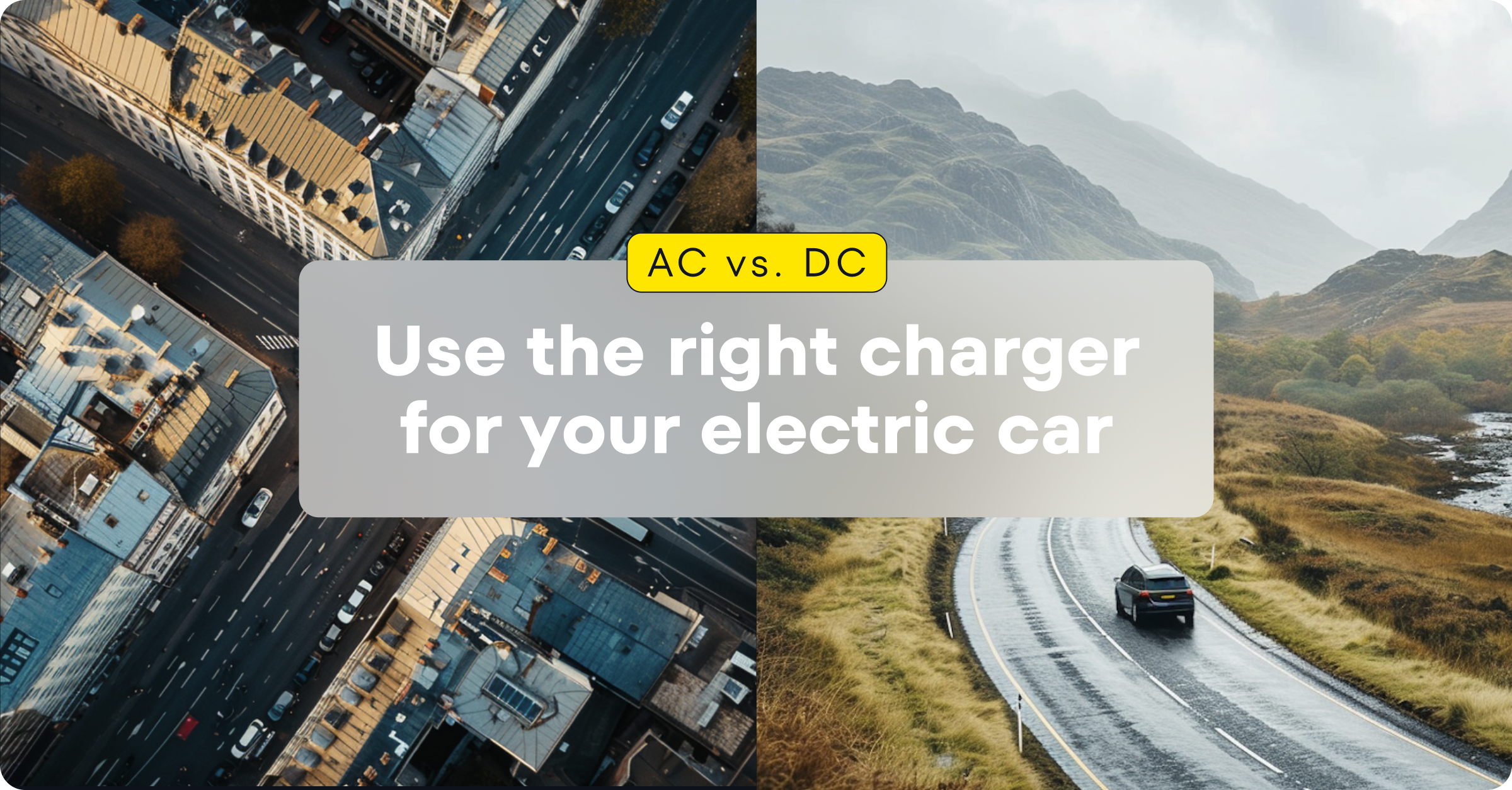
AC and DC – what’s the difference?
There are two types of electric current: alternating current (AC) and direct current (DC).
Alternating current is the type of electricity you get from your wall socket to power everything in your home.
Direct current powers batteries and drives electric engines.
Your EV battery can only store electricity in the DC form. When you charge your car with DC, it goes straight to the battery. However, electric cars have a piece of equipment called a charger. It can convert the alternating current to the direct kind the battery can use.
Because of the lower AC voltage and the extra conversion step, AC charging is slower than using a DC charger.

Why use an AC charger?
In the industry jargon, public AC charging is also called “destination charging”. You can find AC chargers at places you’d visit anyway: typically, they’re individual on-street chargers in city centers and near points of interest.
With charging speeds up to 22kW, AC chargers are perfect for longer charging sessions when running errands. Especially if you don’t have access to a home charger, topping up with an AC charger at every opportunity is a great way to maintain your range.
You’ll need your charging cable to use an AC charger.
Pro tip: Add your car model to the Plugsurfing app to see which plug types your car supports, and use the map settings to find corresponding chargers.
DC charging gets you back on the road
DC chargers are a great option when you must up your battery in minutes, not hours. You may often encounter terms like “high-speed,” “ultra-fast,” and “ultra-rapid” chargers. They’re all DC chargers with different charging speeds. The more kilowatts, the faster you’ll get back on the road.
DC chargers are much bigger than AC chargers and use much power. That’s why they’re usually found at shopping malls, service stations, and office buildings.
Because DC chargers are more expensive to install and maintain, charging with them is often more expensive than using an AC charger.
Pro tip: Using DC chargers is a great way to speed up your road trip. In our new Route planner feature, you’ll see the optimal DC chargers to get from A to B.
What affects your EV charging speed
In addition to the charger you use, four things determine how long it takes for your car to charge:
- Your car model
- Pro tip: if you haven’t added it to your Plugsurfing account, now is the time!
- Remaining battery level
- Other drivers at the charging location
- Temperature
Smaller cars take longer to charge
One big bottleneck in charging speeds is your car itself. Although some DC chargers offer charging speeds up to 350 kW, many EVs sold today can’t take full advantage of these high-power chargers.
Small entry-level electric cars are designed for shorter distances, so installing high-end battery packs and cooling systems for fast charging doesn’t make sense. These more expensive parts drive up costs, making them unsuitable for the mass market. That’s why many low-priced EVs have a maximum charging speed of 50 kW.
High-end electric cars often support faster charging speeds, up to the current maximum of 350 kW. You can expect to put hundreds of kilometers in your battery range at these speeds while having a snack and bathroom break.
Using a fast charger with a slow-charging car shouldn’t break it. Just make sure you understand your car’s limitations. That way, you’re not paying for what you’re not getting.

Charging from 80 to 100 percent takes as long as charging from 0 to 80 percent
An EV battery pack is made up of thousands of electrochemical cells. In an almost empty battery, there are plenty of free cells for the electric charge to occupy. When those cells start to fill up, it takes longer for the electric charge to find a free cell, thus slowing down charging.
Slowing down charging also helps the car’s battery management system to protect the battery from overheating.
In many EV models, you start to see the charging slowing down significantly once the battery reaches 80 percent charge. Some manufacturers also advise against regularly charging the battery above 80 percent.
Someone else is charging too
Charging locations that serve multiple users simultaneously need to ensure there’s enough juice for everyone. Using smart, load-balancing charging hardware aims to solve this.
At peak times, the system rations the electricity so everyone can charge, prioritizing the cars with emptier batteries. This means your car may not get the maximum charging speed if other vehicles use the same charging station.
EV battery works best at around 20°C
Charging the battery and using that charge to run the engine are electrochemical reactions that work optimally at room temperature. In cold weather, these reactions slow down, making charging slower.
In winter, you should remember that charging a cold battery takes longer. You’ll most likely notice this at the fast DC chargers.
When charging at home, you can use your car’s built-in preconditioning feature to warm up the battery before charging. This way, you’ll charge faster, and the car will perform better.
You’ll find more information about preconditioning and cold weather in our Winter charging tips article.

